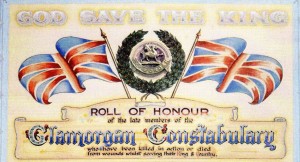The Glamorgan Constabulary Roll of Honour
The ‘Welsh Memorials to the Great War’ project is interested in those memorials which commemorate the service of members of particular communities, be they chapels, clubs, schools or workplaces. Of course, many of these institutions have disappeared or been transformed over the intervening years. In terms of workplaces it is very difficult to find mines or industrial manufactories that are still going concerns.
One institution that still has its place in society is the police force. Here there have been re-organisations, so that the old Glamorgan Constabulary has merged with the formerly independent police forces of Cardiff, Merthyr, Neath and Swansea to form the South Wales Police. The urban police forces have their own memorials to policemen who fell while serving in the First World War, but the focus of this article is the Glamorgan Constabulary.
Outside Police HQ 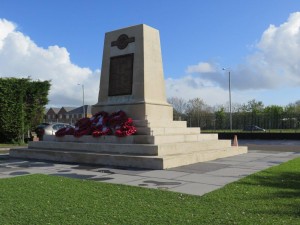 in Bridgend there stands an impressive memorial to the fallen, listing the 58 who were killed in WW1 and 28 who were killed in WW2.
in Bridgend there stands an impressive memorial to the fallen, listing the 58 who were killed in WW1 and 28 who were killed in WW2.
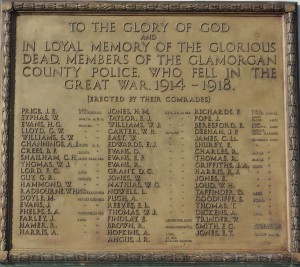
Usually, a striking WW1 Roll of Honour is on display inside the building – 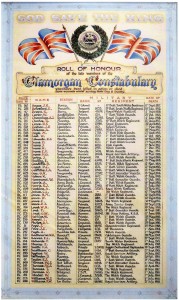 but while some refurbishment is being completed this memorial is currently in the Cardiff station.
but while some refurbishment is being completed this memorial is currently in the Cardiff station.
This impressive memorial lists the 58 names and gives further details of their police service.
The South Wales Police First World War Project Group has been active in researching these men so that it become more than a mere list of names. A series of booklets are being produced, starting off with one which tells the story of those who fell in 1914.
Looking at the booklet about 1915, it is remarkable that five Glamorgan policemen and one Cardiff constable were killed on one day, 27 September 1915, the first day of the Battle of Loos (in Belgium, on the Western Front). Five more south Wales policemen died within a month in that vicinity.
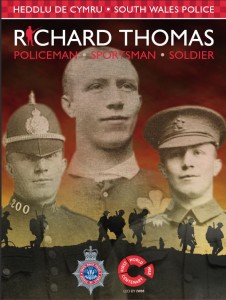
Another booklet tells of the connections between the police forces of South Wales and the Welsh Guards, and one further booklet focusses in on the story of Richard Thomas (known as Dick).
Born in Ferndale in 1881, he was a very well-known sportsman before the war, being capped as a forward four times for Wales between 1906 and 1909. He was part of the Wales team that won the Grand Slam for the first time, when they beat Ireland in March 1908. Although his reputation was as a hard-tackling forward, he occasionally also played as a back for the Glamorgan Police side. To show that he was a real all-rounder, he was also the Glamorgan Police heavyweight boxing champion on three occasions.
In August 1913 Dick was promoted to sergeant and was stationed at Bridgend. However, five months into the War he volunteered for the 16th Battalion of the Welsh Regiment, known as the Cardiff City Battalion. This was part of the ‘Welsh Army Corps’ – raised as part of the recruitment drive headed by Lloyd George with the aim of putting ‘a Welsh army in the field’. After training in Wales, the unit headed off for further training in Winchester before departing for the Western Front as part of the 38th (Welsh) Division.
The division was involved in a major battle for the first time at Mametz Wood, six days into the 1916 Somme campaign. The Cardiff City Battalion were among those ordered to make an assault across open ground to capture the heavily defended wood on 7 July. Dick Thomas was one of the battalion’s 300 casualties that day.
Looking at the Glamorgan Constabulary memorial, you will see details of some others killed in the same battle. Robert Harris (Cardiff City Btn, 7 July 1916), William Edward Trinder (Cardiff City Btn, 7 July 1916) and William Henry Loud (10th (1st Rhondda) Btn, Welsh Regiment, 10 July 1916) were killed as the Welsh took Mametz Wood; Edward Beresford (South Staffordshire Regt, 10 July) was killed nearby in a supporting action.
With thanks to Gareth Madge for his assistance
g.h.matthews April 18th, 2016
Posted In: Uncategorized
